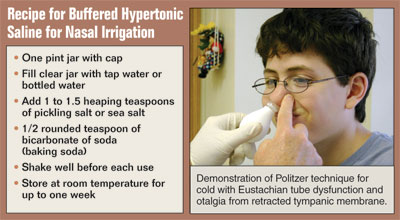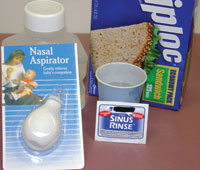Novel uses for the bulb syringe
The nasal syringe can be used to displace thin serous fluid from the middle ear cleft using the Politzer procedure.
The purpose of this article is to educate pediatricians about the usefulness in the pediatric office of the inexpensive 1-oz conical tip bulb syringe that can be purchased at many dollar stores.
Bulb syringes come in at least two major types, the tapered type that is useful to suction the nose and mouth of newborn babies and the conical rigid plastic tip, which is the subject of this article (figure).
Two novel uses for the latter include nasal lavage with hypertonic saline for clearing the nostrils and nasopharynx of mucopurulent material, and instillation of a bolus of air into one nostril synchronous with swallowing a gulp of water to improve or cure Eustachian tube dysfunction or barotrauma caused by airplane travel or diving.

The 1997 CDC/AAP/AAFP Guidelines on Judicious Antibiotic Treatment of Upper Respiratory Infections state that antibiotics should not be prescribed for purulent rhinorrhea, even when accompanied by fever, until at least 10 days of unimproved signs and symptoms have passed. Child care center rules often state that such children may not attend child care programs unless they are receiving an antibiotic. Nasal suction, saline nose spray, intranasal topical vasoconstrictors, such as oxymetazoline or phenylephrine (0.125%), and possibly “decongestant” suspension may suffice to reduce the purulent rhinorrhea without injudicious use of antibiotics. Pediatric otolaryngologists frequently recommend nasal lavage using hypertonic-buffered saline solution (See recipe below).

The conical tip 1-oz nasal syringe is an inexpensive method of power flushing mucopurulent material from the nasal cavity and nasopharynx. The procedure is as follows:
The child is positioned on his/her back with paper drapes under the head. One assistant immobilizes the head and extended arms, while a parent immobilizes the thighs flat against the examination table. The gloved physician or nurse inserts the plastic tip of the bulb syringe firmly against the uppermost nostril with the child’s head turned laterally toward one shoulder. When the bulb is squeezed, 20 to 30 ccs of hypertonic saline enters the uppermost nostril, continues down the nasal passage, enters the nasopharynx and exits out the more dependent nostril, where it is collected into an open zip-lock bag. As the saline flows into the nasal passages, older children are given the command to forcibly blow out through the dependent nostril, aiding in clearing the nose of all secretions. The volume of purulent secretions in comparison to the volume of saline collected gives some objective measure of the probability of bacterial sinusitis. One potential complication of this technique is iatrogenic middle ear effusion, which occurs when the saline/nasal secretion enters and traverses the Eustachian tube and collects in the middle ear cleft. This causes some otalgia and feeling of middle ear fullness. Immediate pneumatic otoscopy is diagnostic of iatrogenic serous otitis media with effusion (OME).
Management of this complication includes recommendation of an analgesic suspension and consideration of an antibiotic. I have not found the antibiotic to be necessary for the majority with this problem.
Otic barotrauma is an injury to the middle ear caused by abrupt changes in air pressure between the middle ear cleft and the environment uncompensated for by a dysfunctional Eustachian tube. The most common cause of barotrauma of the middle ear is pressure changes during descent in aviation. Diving below 6 feet of water can also cause barotrauma, as can forceful sneezing. Normally, swallowing, chewing, yawning or depression of the mandible can aid in equalizing pressure on each side of the tympanic membrane during airplane descent or diving. Otalgia secondary to Eustachian tube dysfunction can be quite bothersome and mimic the discomfort of a middle ear infection. In such cases, the tympanic membrane will be retracted and as such, the short process will be visualized at 2 or 3 o’clock on the left eardrum rather than the normal location at 12 or 1 o’clock. The tympanic membrane will move outward when suction is applied to the lateral surface of the eardrum by means of the pneumatic otoscope and a tympanogram will show a “C” type pattern with its peak pressure far to the left of the normal pressure zone.
To achieve equalization of air pressure on either side of the eardrum and reversal of the relative vacuum in the middle ear cleft, the Politzer technique may be used with the conical shaped nasal bulb syringe. First, the nose must be cleared of any mucus or mucopurulent nasal secretions by suction of the nasal passages or asking a cooperative patient to blow their nose.
Next the child or adolescent is requested to take a sip of water and hold it in their mouth until you give the command to swallow.

Third, the bulb syringe is seated firmly against one nasal aperture and the other nostril is gently pinched closed by the index finger tip not holding the bulb syringe. The final step is when the patient is commanded to swallow a bolus of water and synchronous to deglutition, the bulb syringe is gently squeezed. If the Politzer procedure is performed correctly, some of the bolus of air released into the nasal passage enters and traverses both Eustachian tubes and exits into both middle ear clefts. The act of deglutition causes activation of the tensor palatini muscle and this opens the mouth of the Eustachian tube allowing the bolus of air to enter. A quick look with the pneumatic otoscope will allow the examiner to tell if the eardrum remains in the retracted position or reverts to the normal neutral position. At the same time, the patient is queried if he or she felt discomfort when air entered one or both middle ear clefts. Cooperative patients can practice this technique and relieve the effects of negative middle ear pressure on descent during air travel or after coming up from deep water diving. An exceedingly rare complication of the Politzer technique is iatrogenic air embolism, which can occur if the roof (tegmen tympani) of the mesotympanum (middle ear cleft) is congenitally fenestrated and air bubbles are forced through the tegmen into the circulation.
There are commercially available devices (Otovent), which use an inflated balloon as an air reservoir instead of the nasal bulb syringe.
The conical tipped nasal syringe will prove its worth if used to manage the common middle ear problems described above. In addition to usefulness in nasal toilet and Eustachian tube dysfunction, the nasal syringe can be used to displace thin serous fluid from the middle ear cleft using the Politzer procedure. Don’t be afraid to try these procedures on appropriate patients. Parents will be most appreciative for helping their child without the need for medication.
For more information:
- Richard H. Schwartz, MD, is from the department of pediatrics at Inova Fairfax Hospital for Children, Falls Church, Va.
